| Rheinische Republik
Rhenish Republic |
|---|
|
| Anthem: Die Wacht am Rhein (The watch at the Rhine) |
|
| Capital: Cologne |
| Official Language: German |
| Demonym: German |
| Government: Republic |
| Leader: President Richard von Weizsacker |
| Formation: |
| Area: Roughly 9,000 km2 |
| Population: 20,800,000 |
| GDP: |
| Currency: |
| Timezone: CET |
The Rhineland, officially the Rhenish Republic, (German: Rheinische Republik) is a country in Western Europe. It is bordered in the North and the East by the German Democratic Republic, in the West by the kingdom of Benelux and in the South by the French Republic.
Its territory covers roughly 9,000 km2 and is influenced by a temperate seasonal climate.
History [1] [2][]
Prehistory[]
Palaeolithic
During the Middle Palaeolithic, ca 100,000-30,000 BP (the dates vary a great deal) western Europe, including the Rhine, was occupied by Neanderthal Man, to which belonged the Mousterian culture of stone tools. In fact the Neanderthal man was even named after a place in the Rhenish Republic, the Neandertal valley near Düsseldorf [3].
Neanderthal sites are denser to the south, where open forest prevailed and the limestone terrain offered more caves as dwelling. The Rhine ran through an open tundra, where Neanderthals hunted big game, such as the rhinoceros and the woolly mammoth. Accordingly, open air Mousterian sites have been discovered in and around the Rhine valley.
Mesolithic
Before about 5600 BC, the Rhine Valley, along with most of Europe, was occupied by Cro-magnon man in the Mesolithic stage of cultural development; that is, they hunted and gathered, but owned a larger and more specialized tool kit than the Palaeolithic people, knew more about the plants and animals, and even may have kept a few animals.
Iron Age
During the early Iron Age, both banks of the Rhine were inhabited by Celtic tribes. However, in the beginning of the Pre-Roman Iron Age, ca 600 BC, the Proto-Germanic tribes crossed the Weser River and the Aller River, and expanded the whole distance to the banks of the Rhine. This expansion is shown archaeologically in the form of the Jastorf culture. From ca 500 BC and onwards, the lower Rhine and not the Weser and the Aller would increasingly mark the border between the Celtic tribes and the Germanic tribes.
Roman Empire[]
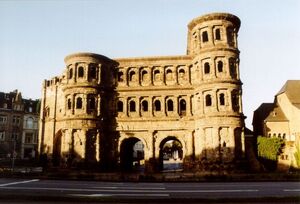
The Porta Nigra in Trier, an important testament of Roman times
Though the Roman campaigns did not have the objective of installing permanent settlements along the Rhine at first, the Battle of the Teutoburg Forest [4] of autum 9 AD in the nowadays GDR, marked an important turning point in the Rhenish history.
The loss of the approximate half of the Roman Rhinearmy and the resulting loss of military power, led the Roman Empire to persueing a new policy for securing its borders to Germania Magma, a policy of pacifying the Roman border provinces, among it Germania Inferior, in which the nowadays Rhenish Republic is found, though an extensive wave of settlements.
Many of the cities of the modern Rhenish Republic, like Trier [5], Koblenz [6] and the Rhenish capital Cologne [7] were founded at this time.
During the mid 4th century Roman military defeats and domestic turmoil led to increasing military confrontations with the Franks, a Germanic tribe, which eventually resulted in the destuction of Cologne and Bonn around 355 AD.
Never the less did the Roman Empire succeed to stay in power for more than 100 years more. In 459 AD did the Roman reign in the nowadays Rhineland end.
The Middle Ages[]
481–687: The Merovingians
687–751: Dominance of the mayors of the palace
751–843: Carolingian Empire
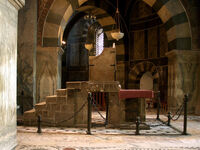
Throne of Charlemagne in Aix-la-Chapelle Cathedral
843-870: The Kingdom of Lotharingia
870-962: Francia Orientalis or the Kingdom of the East Franks
After the death of Lothair II the Kingdom of Lotharingia became divided into three parts with the part of the nowadys Rhineland becoming a duchy of the Kingdom of the East Franks.
With the election of Conrad I ended the Carolingian line in the Kingdom of the East Franks. His successor, Henry I the Fowler , a Saxon, achieved the acceptance of a separate Eastern Empire by the West Frankish (still ruled by the Carolingians) in 921, calling himself Rex Francorum Orientalum (King of the East Franks). He founded the Ottonian dynasty.
962-1806: The Holy Roman Empire
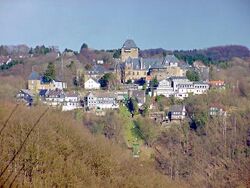
Schloss-Burg an der Wupper, Early residence of the Dukes of Jülich-Berg
Henry designated his son Otto, to be his successor. A marriage alliance with the widowed queen of Italy gave Otto control over that nation as well. His later crowning as Emperor Otto I (later called "the Great") in 962 would mark an important step, since from then on the Eastern-Frankish realm – and not the West-Frankish kingdom that was the other remainder of the Frankish kingdoms – would have the blessing of the Pope. This marks the beginning of the Holy Roman Empire.
At this time the nowadays Rhineland was mainly at the territory of the duchy of Lorraine, which was divided in 959 into the duchies of Upper and Lower Lorraine, with the most North-Eastern part at the territory of the duchy of Saxony and the most South Eastern part in the duchy of Franconia.
The waning influence of the Holy Roman emperors and the gain of might of the territorial lords in the 11th century led to the creation of numerous new territories.
In the Rhineland we can for example prove the Archbishopric of Trier (Reichsfreiheit in 898, confirmed in 902, raised to electorate somewhen between 1189 and 1212), the electorate of Cologne (Bishop Bruno appointed as duke by his brother Emperor Otto I. 953), the County of Berg (first mentioned in 1101),the County of Jülich (raised to a county in 1142) and the Free Imperial City of Aix-la-Chapelle (Reichsfreiheit in 1306).
Modern Times[]
Around 1500-1609: The Dawning of the Modern Age
At the beginning of the modern age, the Rhineland encompassed mainly the Duchy of Jülich-Kleve-Berg in its Northern parts, the Electorate of Cologne and the Free Imperial City of Cologne in the Central Part and several small territories, with the Electorate of Trier and the Free Imperial City of Aix-la-Chapelle as the most notable, in its Southern part.
1609-1614: Jülich-Kleve conflict of succession - a preview of coming attractions

John William, Last Duke of Jülich-Cleves-Berg
The first major conflict in the modern ages in the Rhineland is marked by the Jülich-Kleve War of succession, which forestalled the later Thirty Years' War.
Soon after the death of John William, Duke of Jülich-Cleves-Berg at the 25th of March in 1609, a conflict arouse between the two principal heirs John Sigismund, Elector of Brandenburg and Wolfgang Wilhelm, Count Palatine of Neuburg.
Due to the facts that the catholic Wolfgang Wilhelm received the support of Spain and the Calvinist John Sigismund that of the Dutch the conflict rose from a local to a European and Confessional level.
Only the assassination of Henry IV of France and the connected non-interference of France prevented the conflict from erupting into a full scale European war.
1618-1648: Thirty Years' War
When a European War could still be prevented in the Jülich-Kleve conflict of succession, an incident in another part of the Holy Roman Empire,the Bohemian Revolt, finally triggered this.
While Wolfgang Wilhelm's policy and that of the Free City of Cologne of strict neutrality saved the Northern Parts of the Rhineland from the worst destruction, the Southern parts were not that lucky.
However the economic hardships resulting from the Thirty Years' War affected all of the Rhenish territories.
1792-1815: The French Revolution and the Napoleonic Wars
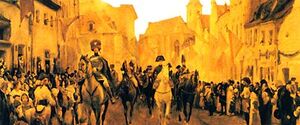
Napoleon in Düsseldorf
The German territories West of the Rhine were among the first territories falling to the Revolutionary French army. This resulted in the creation of the Cisrhenian Republic, the first republic on Rhenish ground, in 1795, which became incorporated into France in 1802.
In 1806 Prince Elector Maximilian I Joseph transfered the last Rhenish territory not under French reign, the Duchy of Jülich-Berg to Napoleon, who united it with the parts of the Duchy of Jülich, which were not incorporated into France, to the Grand Duchy of Jülich-Kleve-Berg with Napoleon's brother-in-law Joachim Murat as Grand Duke.
While this French rule was not popular in all parts of the Rhenish society,it surely provided some new benefits to the Rhenish people, like a modern political system with civil rights, limited participation and, with the code civil, a rule of law.
1815-1822: The Rhine comes under Prussian occupation
After the Congress of Vienna in 1815 Prussia was rewarded for its role in the Napoleonic Wars with the defunct Grand Duchy of of Jülich-Berg, the former Electorate of Cologne, the Electorate of Trier, Manderscheid, Malmedy, the previously Free Imperial City of Aix-la-Chapelle, most of the Palatinate region, parts of Luxembourg and Limburg, as well as a few other small territories.
The first two became, together with the already Prussian Duchy of Cleves, the County of Mark, parts of the Duchy of Gelre and the County of Moers, became the Prussian Province of Jülich-Cleves-Berg and the later the Prussian Grand Duchy of the Lower Rhine.
1822-1923: The Prussian Rhine Province
At 22nd of June 1822 the Prussian Province of Jülich-Cleves-Berg and the Prussian Grand Duchy of the Lower Rhine were unified to the Prussian Rhine Province.
While the Prussians were sensible enough to not abolish the French code civil in the Rhine Province, they did some grave mistakes, like the abolishment of political participation, the introduction of censorship and the ubiquitous presence of Prussian military together with its use against protesters, which led to a growing discontent with the Prussian rule at the Rhine together with a feeling of being again military occupied by a foreign power.
1923-1925: The First Rhenish Republic
The discontent with the Prussian rule together with the economic hardships of the early 1920s led to the first declaration of Rhenish independence by Leo Deckers and Dr. Guthardt in Aix-la-Chapelle in October 1923.
Yet, discord among the Rhenish separatists and the waning support of the local citizenship resulted in a premature end of the First Rhenish Republic in 1925 and the reinsatllation of the Prussian Rhine Province.
1945 - today[]
The German authorities began to crack down on all forms of resistance to the new Socialist regime across the country after the referendum of 1951 saw the Saarland and Trier reject unification with the rest of Germany.
This began a series of attacks against the Catholic Church which was successful across the nation; with the exception of the devout Rhineland in which the government had also attempted to restrict public gatherings and festivities. These new decrees from Berlin proved too much for the Rhinelanders as slogans such as “even the Fascists didn’t ban fun”. Which cumulated in the Carnival Riots of 1956
The Allies soon took interest in this development, as Germany’s industrial heartland an independent Rhineland could truly be a damaging blow to the Soviets! In January 1957, Konrad Adenauer called a meeting in the regional capital of Koblenz and declared the Rhenish Republic which would be governed along democratic roots. This new country was immediately recognised as legitimate by Western European countries, and the German authorities were unwilling to pursue the Rhinelanders as they seemed to be a people who were not mouldable to “socialist ideals”.
German forces withdrew and French troops took up the defence of the Rhineland, they still serve to protect the Rhineland today as the treaty of Rhenish Independence signed by the GDR and the EEC states that the Rhenish Republic may not have a military that is larger than 100,000 troops.
Geography[]
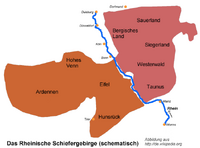
Map of the Rhenish Slade Mountains
The most North-Eastern part of the Rhenish Republic lies in the Northern European Lowlands which extends South to the Cologne Bay, while the Eastern and Southern parts are part of the Rhenish Slade Mountains.
Climate[]

The wineyards of the Moselle River
While the Northern part of the Rhineland has due an influence of the Atlantic Ocean an Oceanic Climate with mild summers and winters and heavy rainfall, the climate of the Southern part can be described as Pannonic with warm and dry summers.
This results into the fact that the Southern part of the Rhineland is the main producer of wine on German soil.
Administrative Subdivisions[]
The Rhenish Republic is subdivided into six administrative districts:
- Administrative District Aix-la-Chapelle
- Administrative District Dortmund
- Administrative District Düsseldorf
- Administrative District Kobenz
- Administrative District Cologne
- Administrative District Trier
Government[]
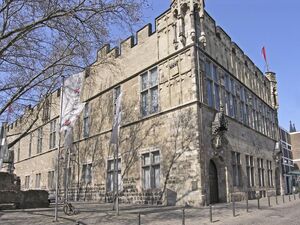
The Gürzenich in Cologne. The Rhenish parliamentary building ((OOC: My proposal. Please change it, if you have other ideas :) ))
To be answered by the player.
Proposed Parties:
Zentrum (Christian Democrats, center-right, conservatives)
SPD (Social-Democrats, center-left, NO Marxists)
DDP (Deutsche Demokratische Partei, German Democratic Party, liberals)
DVP (Deutsche Volkspartei: Nationalists, right-wing, NO nazies)
Foreign Relations[]
The Rhenish Republic has good relations to France and the UK and is allied with those powers.
By being a strong Roman-Catholic nation it further has excellent relations with the Papal States and other pious Catholic nations.
Its relations to the Communist nations, exspecially the GDR are icy at best.
National Anthem[]
The Rhenish national anthem is the song "Die Wacht am Rhein (The watch at the Rhine)".
Although the text is originally directed against French expansionist ambitions, it is now understood as a waning against the GDR.
| German lyrics | Approximate translation |
|---|---|
| 1st stanza | |
|
Es braust ein Ruf wie Donnerhall, |
A call roars like thunderbolt, |
| refrain | |
|
Dear fatherland, put your mind at rest, |
| 2nd stanza | |
|
Durch Hunderttausend zuckt es schnell, |
Through hundreds of thousands it quickly twitches, |
| 3rd stanza | |
|
Er blickt hinauf in Himmelsau'n, |
He looks up to the meadows of heaven, |
| 4th stanza | |
|
Solang ein Tropfen Blut noch glüht, |
As long as a drop of blood still glows, |
| 5th stanza | |
|
Der Schwur erschallt, die Woge rinnt |
The oath rings out, the billow runs |
Military[]
The Rhenish military is limited to 100,000 troops due to a treaty with the GDR and the EEC.
Demographics[]
People[]
The Rhenish people are originally Franks, with Low Franks in the Northern Part and Ripuarian Franks from Cologne on South.
Later the Romans left its mark on the Rhenish people West from the Rhine, resulting in the archetypal citizen of Cologne being dark-haired and brown-eyed.
The Rhenish people are often pictured having an easygoing lifestyle, characterized by a vivid tradition of carnival, the cultivation (and consumption) of wine and a regional tradition of songs and singing ("Rhenish songs") - markedly contrasted against the supposedly "stiff" Prussians and Westphalians
A traditional half-serious rivalry between the cities of Cologne and Düsseldorf exist, which is mainly expressed in differing Carnival Greetings (Alaaf in Cologne, Helau in Düsseldorf), disagreements about the better kind of beer ("Kösch" in Cologne, "Alt" in Düsseldorf) and mocking jokes.
Language[]
While Standard German is the official language of the Rhenish Republic, the spoken dialects can be classified into three broad dialect groups.
- Low Franconian at the territories North of the Uerdingen Line.
- Ripuarian Franconian between the Uerdingen Line and the Vinxtbach Line.
- Moselle Franconian and Rhine Franconian South of the Vinxtbach Line.
All of those dialect groups again split into numerous smaller dialect groups.
Religion[]
The Rhinelands are a traditional Roman-Catholic stronghold and the Roman-Catholic church still holds significant moral influence in the devout Rhenish Republic.
Since the Roman-Catholic church has played a significant role in achieving Rhenish independence the church membership has even increased since then at the cost of the other faithes.
80 % Roman-Catholic, 15 % Protestant, 5 % other
Economy[]
Culture[]
Rhenish Festivals[]
The Rhenish Carnival
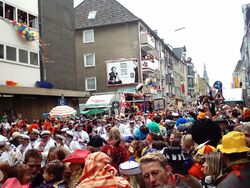
Rose Monday Parade in Cologne
The Rhenish carnival is a carnival that takes place in the Rhinelands every year starting at 11:11 on November 11 culminating in a week-long street festival leading up to Ash Wednesday. The eleventh of November constitutes a single day of celebration, and the immediate lead-up to Ash Wednesday several more. The highlight of the carnival is the Rosenmontag which takes place on the Monday. The typical cry during the festival is "Kölle Alaaf!"in the areas around Cologne and "Helau!" in Düsseldorf and its surroundings.
The street festival is marked by large parades with the largest one, the Rose Monday Parade in Cologne regularly attracting more than one million visitors.
The Schützenfeste
A Schützenfest (German "marksmen's festival") is an annual traditional festival celebrated in the Rhineland as well as in Bavaria. It is a kind of local fair featuring a shooting match among members of the local marksmen's association and usually takes place in summer.
At a Schützenfest, contestants compete their shooting abilities, for example by shooting at a wooden representation of an eagle. The winner of the competition becomes the 'Schützenkönig' ("king of marksmen") until the next year's competition.
The marksmen's association originate from medieval town militias, which were fonded to protect the local towns from being looted by robbers.
Rhenish Food[]
Rheinischer Sauerbraten

Rhenish Sauerbraten made from horse meat
One of the internationally most well known German dishes is the Sauerbraten, which is traditional in the Rhineland, Saarland, Silesia, and Swabia.
In contrast to the other variants the Rhenish Sauerbraten is sweetish and contains raisins and sometimes gingerbread.
The meat is marinated in vinegar, a sweetening agent such as sugar beet syrup, apple syrup, or sugar, and seasonings containing juniper cones and cloves, and then braised. The sauce contains raisins and often crushed gingerbread.
While it is traditionally made from horse meat, it is nowadays more and more prepared from beef.
Carp blue
Carp blue is a traditional Rhenish New Year's Eve dish.
For preparing it, it is of uttermost importance that the outer mucus layer of the carp remains unharmed. To achieve this the fish is only washed and salted on its inside.
Afterwards the carp is doused with a decoction made from warm water, white wine, vinegar,onions, laurel and peppercorns.
The carp is coloured in a bright blue after this procedure.
Rhenish Mussels
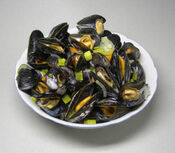
Rhenish Mussels
Due to the important role of the Rhine river for European trade, blue mussels from the Northern Sea and white wine from the Southern parts of the Rhineland led to the creation of another traditional Rhenish dish, the Rhinesh Mussels.
For preparing it blue mussels have to be carefully cooked in a broth prepared from butter, onions, leek, carrots, celery, white whine, salt, peppercorns, laurel, allspice, clove and garlic.
Halver Hahn
If the non-native orders a "Halver Hahn" in Cologne, he may experience an unpleasant surprise. Instead of half a rooster like the name suggest, he will be served a rye bread roll with Gouda cheese.
While plenty of explanations for the unusual name are existing, non of them are provable and in fact most of them are anecdotic.
A Halver Hahn is traditionally enjoyed together with a Kölsch beer.
Himmel un Ääd
Himmel un Ääd, Ripuarian for "heaven and earth", is a traditional Rhenish dish.
It is prepared from mashed potatoes (where it gets the earth part of the name from) and apple sauce (the heaven part) and served together with fried black pudding.
Pannas
Pannas, which is also known in Westphalia and the Dutch part of Benelux (here under the name of Balkenbrij), is a kind of black pudding prepared from meat broth, buckwheat flour, hacked pork or beef, salt, pepper, allspice, clove and blood.
Since it has to be eaten fresh, it is a traditional dish of the slaughter time in autumn.
Bergisch Coffee Table
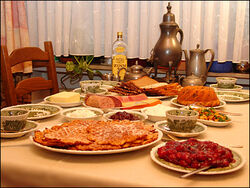
Koffeedrenken met allem Droem on Dran
For a long time the people in "Bergisch Land" love their coffee table, "Koffeedrenken met allem Droem on Dran (in the local Low-Frankonian dialect roughly: Drinking coffee with everything with all the bells and whistles)".
In the afternoon the table will be covered with a specially designed set of porcelain ("Zwiebelmuster" - onion pattern). Following an old tradition the coffee table is composed of "Rosinenstuten" (a plum cake), rice-milk, "Bergischer Zwieback" (a sort of sweet cracker), honey, dark bread, curd, cheese, ham, sausage, butter, waffles, sugar and cinnamon, "Burger Brezeln" (pretzel), stewed apples and the "Dröppelmina". Dröppelmina is an intermediate between coffee mashine and coffee pot, which functions similar to an Russian "samovar".
The Rhenish beers Kölsch and Alt
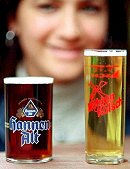
Alt (left) and Kölsch (right), the two Rhenish beer variants
The Bavarian Reinheitsgebot of 1516, was drawn up to ensure the production of decent-quality beer; however, this decree did not affect brewers of the Rhineland. As such, the brewing traditions in this region developed slightly differently. For example, brewing during the summer was illegal in Bavaria, but the cooler climate of the Rhineland allowed brewers to brew all year long and to experiment with storing fermented beer in cool caves and cellars.
This led towards the fact that the most consumed kinds of beer are the ale variants Kölsch and Alt in contrast to the lager Pils which dominates the rest of Germany.
the Cologne centered Kölsch stands in direct competition to Altbier, the production of which is centred around Düsseldorf, but which is ironically also produced by all the major breweries in Cologne; the difference between the two types is indeed technically slight, Altbier being fermented at slightly higher temperatures than Kölsch and using dark malt, harder water and far more bittering hops, resulting in a nuttier, firmer and more dry taste.
The rivalry between the cities of Cologne and Düsseldorf, bitter in the past but today mostly a humorous matter, is often expressed by the preference of one of these types of beer, and ordering the wrong kind in the wrong city has in fact resulted in abuse and even violence in the past, although today a couple of jokes about foreigners is probably all that would result.

